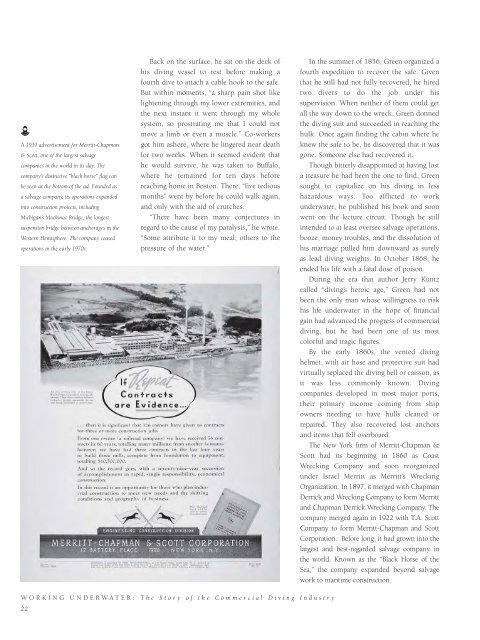Working Underwater: The Story of the Commercial Diving Industry
An illustrated history of the commercial diving industry paired with the histories of companies that have helped shape the industry.
An illustrated history of the commercial diving industry paired with the histories of companies that have helped shape the industry.
Create successful ePaper yourself
Turn your PDF publications into a flip-book with our unique Google optimized e-Paper software.
A 1939 advertisement for Merritt-Chapman<br />
& Scott, one <strong>of</strong> <strong>the</strong> largest salvage<br />
companies in <strong>the</strong> world in its day. <strong>The</strong><br />
company’s distinctive “black horse” flag can<br />
be seen at <strong>the</strong> bottom <strong>of</strong> <strong>the</strong> ad. Founded as<br />
a salvage company, its operations expanded<br />
into construction projects, including<br />
Michigan’s Mackinac Bridge, <strong>the</strong> longest<br />
suspension bridge between anchorages in <strong>the</strong><br />
Western Hemisphere. <strong>The</strong> company ceased<br />
operations in <strong>the</strong> early 1970s.<br />
Back on <strong>the</strong> surface, he sat on <strong>the</strong> deck <strong>of</strong><br />
his diving vessel to rest before making a<br />
fourth dive to attach a cable hook to <strong>the</strong> safe.<br />
But within moments, “a sharp pain shot like<br />
lightening through my lower extremities, and<br />
<strong>the</strong> next instant it went through my whole<br />
system, so prostrating me that I could not<br />
move a limb or even a muscle.” Co-workers<br />
got him ashore, where he lingered near death<br />
for two weeks. When it seemed evident that<br />
he would survive, he was taken to Buffalo,<br />
where he remained for ten days before<br />
reaching home in Boston. <strong>The</strong>re, “five tedious<br />
months” went by before he could walk again,<br />
and only with <strong>the</strong> aid <strong>of</strong> crutches.<br />
“<strong>The</strong>re have been many conjectures in<br />
regard to <strong>the</strong> cause <strong>of</strong> my paralysis,” he wrote.<br />
“Some attribute it to my meal; o<strong>the</strong>rs to <strong>the</strong><br />
pressure <strong>of</strong> <strong>the</strong> water.”<br />
In <strong>the</strong> summer <strong>of</strong> 1856, Green organized a<br />
fourth expedition to recover <strong>the</strong> safe. Given<br />
that he still had not fully recovered, he hired<br />
two divers to do <strong>the</strong> job under his<br />
supervision. When nei<strong>the</strong>r <strong>of</strong> <strong>the</strong>m could get<br />
all <strong>the</strong> way down to <strong>the</strong> wreck, Green donned<br />
<strong>the</strong> diving suit and succeeded in reaching <strong>the</strong><br />
hulk. Once again finding <strong>the</strong> cabin where he<br />
knew <strong>the</strong> safe to be, he discovered that it was<br />
gone. Someone else had recovered it.<br />
Though bitterly disappointed at having lost<br />
a treasure he had been <strong>the</strong> one to find, Green<br />
sought to capitalize on his diving in less<br />
hazardous ways. Too afflicted to work<br />
underwater, he published his book and soon<br />
went on <strong>the</strong> lecture circuit. Though he still<br />
intended to at least oversee salvage operations,<br />
booze, money troubles, and <strong>the</strong> dissolution <strong>of</strong><br />
his marriage pulled him downward as surely<br />
as lead diving weights. In October 1868, he<br />
ended his life with a fatal dose <strong>of</strong> poison.<br />
During <strong>the</strong> era that author Jerry Kuntz<br />
called “diving’s heroic age,” Green had not<br />
been <strong>the</strong> only man whose willingness to risk<br />
his life underwater in <strong>the</strong> hope <strong>of</strong> financial<br />
gain had advanced <strong>the</strong> progress <strong>of</strong> commercial<br />
diving, but he had been one <strong>of</strong> its most<br />
colorful and tragic figures.<br />
By <strong>the</strong> early 1860s, <strong>the</strong> vented diving<br />
helmet, with air hose and protective suit had<br />
virtually replaced <strong>the</strong> diving bell or caisson, as<br />
it was less commonly known. <strong>Diving</strong><br />
companies developed in most major ports,<br />
<strong>the</strong>ir primary income coming from ship<br />
owners needing to have hulls cleaned or<br />
repaired. <strong>The</strong>y also recovered lost anchors<br />
and items that fell overboard.<br />
<strong>The</strong> New York firm <strong>of</strong> Merritt-Chapman &<br />
Scott had its beginning in 1860 as Coast<br />
Wrecking Company and soon reorganized<br />
under Israel Merritt as Merritt’s Wrecking<br />
Organization. In 1897, it merged with Chapman<br />
Derrick and Wrecking Company to form Merritt<br />
and Chapman Derrick Wrecking Company. <strong>The</strong><br />
company merged again in 1922 with T.A. Scott<br />
Company to form Merritt-Chapman and Scott<br />
Corporation. Before long, it had grown into <strong>the</strong><br />
largest and best-regarded salvage company in<br />
<strong>the</strong> world. Known as <strong>the</strong> “Black Horse <strong>of</strong> <strong>the</strong><br />
Sea,” <strong>the</strong> company expanded beyond salvage<br />
work to maritime construction.<br />
WORKING UNDERWATER: <strong>The</strong> <strong>Story</strong> <strong>of</strong> <strong>the</strong> <strong>Commercial</strong> <strong>Diving</strong> <strong>Industry</strong><br />
22
















